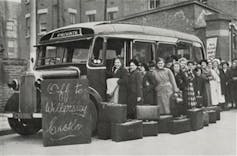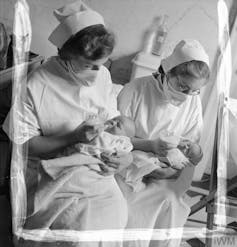Average Cost to Have Baby in Hospital in 1942
NHS maternity services are stretched and infant bloodshed rates in the Great britain are some of the worst in Europe. At terminal count, equally many every bit 97.nine% of births took place in infirmary – despite the fact that hospital births aren't ever safer. Really, the reason why the vast majority of women give nascence in infirmary has more to do with history, than with health outcomes.
During the early decades of the 20th century, the state was highly focused on making sure children survived into machismo, equally the national nascence rate had been declining since 1918. Funding was ploughed into maternity and child services, to give children the best start. At the outbreak of Globe State of war Ii, preparations began to evacuate meaning women shut to giving birth to emergency maternity hospitals in the countryside, for their confinement.
Until this time, about women gave birth at home, usually with the help of a midwife. But this became much more difficult during the war, as midwifery services had been moved to the emergency hospitals outside the UK's major cities. Today, research tells us that home births are ofttimes a safer pick than hospital births. But while the NHS are trying to encourage women to consider home birth as an option, information technology's proving hard to kick the nation'southward habit of going to hospital.
Wartime Evacuation
On September 2, 1939, over 12,000 pregnant women left their homes to take upward adaptation in rural areas to await the arrival of their baby. These women were expected to give nascence in hastily amassed maternity "hospitals" provided past the Ministry of Health, and then stay at their countryside billets for the residuum of the war.

The evacuation was often shambolic, with reports of buses total of women ending upward in the wrong places, while some had to hitchhike home with babes in arms. By the summer of 1940, nighttime air raids were escalating, and this "emergency maternity service" was under increasing strain. There was a shortage of midwives, and medical staff were often in the incorrect identify at the wrong time.
Billets for women waiting to enter or leave infirmary became increasingly difficult to find. Pregnant women were seen as a troublesome type of evacuee in comparison with children and unattached military personnel, and the rates of compensation provided to householders for housing them were far lower than for other groups.
All the same, at that place were more than 10,500 births in the emergency maternity homes in 1940, and this number virtually tripled the following year. Even though the United kingdom experienced less bombing during 1941, expectant mothers were leaving London for their confinements in droves.
The London boroughs were simply unable to meet need for either dwelling house or hospital births. Bombing had destroyed a number of hospitals, and the upper floors of those still functioning were closed due to fears of further damage. Midwifery staff had been relocated to the land maternity homes and therefore there really was little selection for women just to get where the facilities were.
From mid-1942 onwards, some 1,000 to one,500 women left the evacuation areas per month and emergency maternity homes were overflowing, pregnant referrals had to be suspended. The bombs were no longer the reason that women were leaving the urban center to give birth – the beds were. Accordingly, in 1942 the regime inverse how it described the scheme, from an evacuation scheme to a "special scheme of country maternity homes for city mothers".
The hospital addiction

During the war, the state finer constructed a national maternity arrangement, with roughly 5,000 beds added to hospitals, which had offered strained and patchy maternity services at the onset of war. Prior to the Maternity and Child Welfare Act of 1918, country involvement in the delivery of babies would take been unimaginable. But following growing state investment and involvement before the war, the authorities had crossed the final threshold and taken responsibleness for safe nascency – where "safety" meant "in hospital".
Subsequently constructing this national system, which meant that women could more easily access institutional maternity care, information technology proved difficult to reverse. When the Ministry building of Wellness tried to close the evacuation scheme in 1947, its efforts were met with outcries from the London boroughs, which merely had no way of providing enough hospital beds for expecting women who wanted them.
The touch on of this change resonated through the century: in the 1930s, home births in the Great britain accounted for over ninety% of confinements, but by 1955 they made up just 33.iv%. By the 1980s, the do of dwelling house nascency was almost eliminated, with only 0.9% of births taking place at dwelling.
This trend too emerged in other Western democracies throughout the 20th century, only for different reasons. For example, home nascency had been declining sharply in the US before World War II, with effectually 70% of births taking place in hospital by 1930. The US system also moved away from the do of midwifery, to rely exclusively on the obstetric doctor. Merely 0.9% of births in the US in 2017 were at dwelling house, a quarter of which were unplanned.
Despite an increasing uptake in hospital births for more than complex cases, the United kingdom of great britain and northern ireland had largely held on to midwife-led habitation nascence during the interwar period. The wartime arrangements accelerated what had been a slow-called-for alter.
Today, NICE guidelines actively promote home birth every bit a rubber choice for women having 2nd or subsequent babies, and in 2017 home births had risen to 2.i%. But information technology's even so very much the norm to go to hospital. Women may no longer need to trek to the countryside, but the urge is still the same. In this time of extreme NHS strain, women are still heading to where the staff, and beds are.
Source: https://theconversation.com/most-women-give-birth-in-hospital-but-its-got-more-to-do-with-world-war-ii-than-health-110647
0 Response to "Average Cost to Have Baby in Hospital in 1942"
Post a Comment